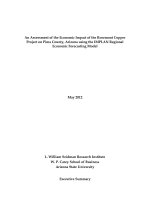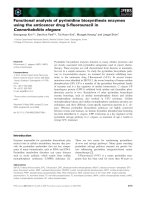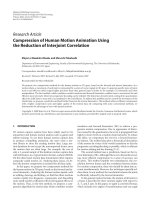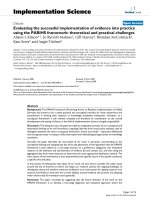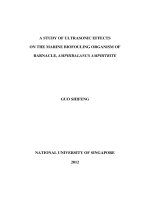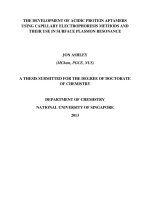Bioremediation of piggery slaughterhouse wastewater using the marine protist, Thraustochytrium kinney VAL-B1
Bạn đang xem bản rút gọn của tài liệu. Xem và tải ngay bản đầy đủ của tài liệu tại đây (872.35 KB, 6 trang )
Journal of Advanced Research 12 (2018) 21–26
Contents lists available at ScienceDirect
Journal of Advanced Research
journal homepage: www.elsevier.com/locate/jare
Original Article
Bioremediation of piggery slaughterhouse wastewater using the marine
protist, Thraustochytrium kinney VAL-B1
María P. Villarroel Hipp a, David Silva Rodríguez b,⇑
a
b
Ingeniería Ambiental, Universidad de Los Lagos, Camino a Chinquihue km. 6 s/n, Puerto Montt 5480000, Chile
Departamento de Recursos Naturales y Medio Ambiente, Universidad de Los Lagos, Camino a Chinquihue km. 6 s/n, Puerto Montt 5480000, Chile
g r a p h i c a l a b s t r a c t
a r t i c l e
i n f o
Article history:
Received 20 October 2017
Revised 27 January 2018
Accepted 29 January 2018
Available online 22 March 2018
Keywords:
Thraustochytrid
Meat-processing industry
Pig slaughtering plant
Environmental pollution
Chemical oxygen demand
Iron
a b s t r a c t
Industrial wastewaters from pig slaughtering plants (PSPs) generated in the slaughtering process could
have an environmental impact, if discharged to a receiving water body without any treatment. In this
study, a Chilean Thraustochytrid (TH) strain, a class of marine protist, was used for the bioremediation
of piggery slaughterhouse wastewater (SWW). According to the physicochemical analysis of the residue,
it was characterized by an initial chemical oxygen demand (COD) of 9610 mg LÀ1, 18,625 mg LÀ1 of oil
and grease, 1639 mg LÀ1 of total nitrogen, 149 mg LÀ1 of total phosphorus, and 82.41 mg LÀ1 of total iron.
Growth studies were conducted to evaluate the growth and biomass production of the strain on residuebased media and its subsequent bioremediation ability. After 5–7 days of fermentation, the results
showed that COD of the medium supernatant was reduced by 56.29% (4200 mg LÀ1), while oil and grease
had a significant decrease about 99% (18 mg LÀ1), and the content of total nitrogen, total phosphorus, and
total iron were also decreased by 63.27% (602 mg LÀ1), 97.55% (3.65 mg LÀ1) and 60.35% (30.88 mg LÀ1),
respectively. With these results, it was concluded that VAL-B1 can be used for the bioremediation of
industrial wastewater from PSPs, and therefore THs could contribute to regulate the environmental
pollution.
Ó 2018 Production and hosting by Elsevier B.V. on behalf of Cairo University. This is an open access article
under the CC BY-NC-ND license ( />
Introduction
Peer review under responsibility of Cairo University.
⇑ Corresponding author.
E-mail address: (D. Silva Rodríguez).
Food industry generates a great variety of residues and
constitutes one of the most harmful productive sector for the
environment [1], especially industrial wastewater (IWW), which
consists in residual water generated in industrial establishments
/>2090-1232/Ó 2018 Production and hosting by Elsevier B.V. on behalf of Cairo University.
This is an open access article under the CC BY-NC-ND license ( />
22
M.P. Villarroel Hipp, D. Silva Rodríguez / Journal of Advanced Research 12 (2018) 21–26
after being used in different processes, activities or services, and it
is considered one of the most important contamination sources in
the environmental pollution [2]. There are different types of IWW,
based on the industries and the contaminants, in which each sector
produces its own particular combination of pollutants [3]. Among
these types of IWW, meat-processing sector is one of the mostwater consuming industry [4], which produces high volume of
slaughterhouse wastewater (SWW) generated from slaughtering
process of animals, and contains various and high amounts of proteins, blood, fat, oil, feathers, lard, bones, microorganisms, hair,
flesh, manure, etc. [5] and sometimes it can also contain heavy
metals, disinfectants, cleaning agents, and pharmaceuticals for veterinary purposes [6]. The main pollutant in slaughterhouse discharges is organic matter, in which the chemical oxygen demand
(COD) ranges between 500 and 15,900 mg LÀ1 [7]. Due to these
characteristics, SWW could have a significant environmental
impact if are discharged to a receiving environment (e.g., oceans,
seas, lakes or groundwater) without a previous treatment. Within
the possible treatments which could be applied for the management of these type of IWW, bioremediation is a technique that
has acquired an increasing importance for waste treatment, which
involves the use of microorganisms, plants, fungus, etc. to remove
or neutralize pollutants from a polluted site, either by absorbing,
degrading, removing or transforming the toxic compounds into
harmless or less toxic metabolic products [8,9]. In the recent years
there has been an increasing interest on a marine eukaryotic protist belonging to the phylum Labyrinthulomycota, which is classified as an oleaginous microorganism [10,11], called
thraustochytrid (TH). THs grow on a heterotrophic medium (e.g.,
with glucose, fructose and starch as carbon sources and yeast
extract, monosodium glutamate and peptone as nitrogen sources),
and commonly require micronutrients, such as, vitamin B1 (thiamine) and vitamin B12 (cobalamine) for normal growth, and
more recently, it has been reported that culture medium containing trace elements (e.g., iron and zinc) have a positive effect on
microorganism growth [12]. On the other hand, this microorganism is known for its ability to produce biomass rich in lipids, with
high content of polyunsaturated fatty acids (PUFAs), such as,
docosahexanoic acid (DHA) and eicosapentaenoic acid (EPA). In
addition, it has been demonstrated that THs are able to use different residues as a substrate for their growth and biomass production, for example, okara, a residue of soy milk [13], crude
glycerol [14], coconut water [15] and bread crumbs [16]. However,
since most of the investigations are focused on the biotechnological application of the microorganism (PUFAs production), the
bioremediation potential of THs has been scarcely evaluated, and
there are few studies in which researchers observed that THs can
act favorably on the pollutant load of residues and decrease the
concentration of physicochemical parameters, such as COD
[17,18], total nitrogen, nitrate, ammonia and phosphate content
on different residues of food industry [19,20]. Thus, the aim of this
work was to evaluate the bioremediation ability of a native strain
of TH in piggery SWW. Here, we determined the appropriate concentration for the optimal use of residue and biomass production
by the microorganism, and evaluated the physicochemical parameters before and after the cultures. This is the first report that uses
a Chilean thraustochytrid strain for the bioremediation of piggery
slaughterhouse wastewater.
NaCl, MgClÂ6H2O, MgSO4Â7H2O, streptomycin sulfate, Penicillin
G were purchased from Sigma-Aldrich (Steinheim, Germany). Agar,
peptone, yeast extract (YE), NaHCO3 and FeCl3Â6H2O were purchased from Becton Dickinson and Co. (New Jersey, USA), Oxoid
(Wade Road, Basingstoke, United Kingdom), Himedia (Mumbai,
India), Synth (Diadema, Brazil) and Scharlau (Sentmenat, Spain),
respectively, and FAME standard mixtures were obtained from
Sigma-Aldrich (Missouri, USA).
Residue
The residue was obtained from a piggery cold meat factory, and
corresponds to the animal blood mixed with water used for cleaning of facilities, and with solid residues (animal’s fat, hair, meat
residue, etc.) generated in the pig slaughtering process. The residue
was homogenized on a magnetic stirrer, and filtered with cheesecloth, and then by using filter paper (Advantec, No. 1, Tokyo, Japan)
for its use during this study.
Microorganism
A Chilean strain from Thraustochytriidae family, Thraustochytrium kinney VAL-B1 (Fig. 1) (GenBank accession number:
KF709393), isolated from Carvallo beach’s coastal zone at Valparaíso, Chile (geographic coordinates: 33°10 900 S 71°380 3000 W) was
used [21]. The strain was kept at 4 °C in B1 solid medium (for 1 L
of artificial seawater (ASW): peptone 1 g, YE 1 g, agar 10 g; pH
6.5) containing streptomycin sulfate and penicillin G (300 mg LÀ1).
Culture conditions
The inoculum was prepared by transferring cells from agar B1
solid medium to 50 mL of sterile medium B2 (for 1 L ASW: glucose
10 g, YE 2 g, MSG 2 g). The incubation in Erlenmeyer flasks was
held for 48 h at 25 °C with orbital shaking at 180 rpm, according
to Hinzpeter et al. [22].
Selection of the appropriate concentration for the optimal use of
residue
The residue-based media were prepared by adding YE-MSG
(both at 2 g LÀ1), and the residue at different dilutions (25, 50, 80
and 100% of residue) with ASW (for 1 L: NaCl 27.5 g, MgCl2Â6H2O
5.38 g, MgSO4Â7H2O 6.78 g, KCl 0.72 g, NaHCO3 0.2 g and CaCl2Â2H2O 1.4 g, at 29 PSU), followed by the adjusting of pH at 6.5
Material and methods
Chemicals
Monosodium glutamate (MSG), glucose (Gluc), C2H6O, CH3OH,
HCl, NaOH, CHCl3, C6H14, CaCl2Â2H2O, KCl and standard solutions
of Zn, Fe, Cu were purchased from Merck (Darmstadt, Germany).
Fig. 1. Epifluorescence microscopy of Thraustochytrium kinney VAL-B1 showing (a)
vegetative cells attached to (b) pine polen (Leica DM IL, Germany). Scale bar 10 mm.
M.P. Villarroel Hipp, D. Silva Rodríguez / Journal of Advanced Research 12 (2018) 21–26
23
and autoclaving (121 °C, 15 min). Sterile growth media (100 mL)
were inoculated (inoculum size used was 5% of the total volume
of the media, 5% v/v, and optical density of inoculum was 0.6 at
600 nm), and incubated at 25 °C in Erlenmeyer shaking flasks at
180 rpm (LabTech LSI-3016A, United Kingdom), for 5 days.
4500 rpm for 5 min, and were stored at À20 °C until analyzed. The
resulting FAMEs were analyzed by Gas Chromatography (Agilent
7890A, Santa Clara, California, USA). The FAMEs’ peaks were
identified and quantified using fatty acid standards (Supelco 37
Component FAME Mix 47885-U, Sigma-Aldrich, Missouri, USA).
Analytical methods
Chemical oxygen demand (COD)
A COD curve was carried out by preparing cultures in a one L
stirred culture vessel (Nalgene 2605-0001, Thermo Scientific, Waltham, Massachusetts, USA), containing 900 mL of residue-ASW
salts (residue at the selected concentration for its optimal use),
YE-MSG (both at 2 g LÀ1) and 100 mL of inoculum, adjusting the
pH and salinity of the medium before being autoclaved. Cultures
were incubated for 7 days at 25 °C and 180 rpm. COD was measured on medium supernatant containing the wastewater before
and after the cultivation (collecting supernatant every 24 h for
analysis) by photometric method according to NCh2313/24 [27]
using COD kits (Merck, Darmstadt, Germany). The organic matter
of the sample (3-mL aliquot) was oxidized with a hot sulfuric solution of potassium dichromate at 150 °C for 2 h in COD tubes. After
that, the COD tubes were removed from the oven allowing them to
cool down on a test-tube rack for 10 min, swirled and returned to
the rack for complete cooling to room temperature (30 min,
approximately). COD levels were determined by measuring the
absorbance of the digested assay solution with a spectrophotometer at 600 nm. A 1 cm path length was maintained by using a standard cuvette (2.5 mL sample size).
Biomass production
Growth was quantified by measuring the accumulation of the
TH biomass throughout the fermentation. Total biomass was
recovered by centrifugation (Hermle Z326k, Wehingen, Germany)
at 4000 g (6000 rpm), 4 °C for 15 min, and washed three times with
sterile distilled water. The cell pellets were lyophilized (Thermo
Savant ModulyoD-230, New York, USA) and their weight were
gravimetrically determined. The biomass samples were stored at
À20 °C until fatty acids extraction.
Characterization of residue
Characterization of the residue before the biological treatment
(raw SWW) was based on sampling procedure during normal operation of the plant, while for the characterization of the residue after
the biological treatment, fermentations of 1 L were conducted in a
1-L stirred culture vessel (Nalgene 2605-0001, Thermo Scientific,
Massachusetts, USA), containing 900 mL of residue-ASW salts
(residue at the selected concentration for its optimal use mixed
with artificial sea salts), YE-MSG (both at 2 g LÀ1) and 100 mL of
inoculum, adjusting the pH and salinity of the medium before
being autoclaved. Cultures were incubated for 5 days at 25 °C
and 180 rpm, without external agitation. After fermentation, the
supernatant samples were collected by one centrifugation cycle
at 4000 g (6000 rpm), 4 °C for 15 min, and stored for further analyses (proximate and trace elements analysis).
Proximate analysis
Proximate composition in the residue (raw SWW) and in the
supernatant (after the treatment) of 5-day cultures (1 L) were
determined by the Laboratory of Environmental Tests of Universidad de La Frontera (Temuco, Chile). Total Nitrogen test was carried
out by Kjeldahl method according to Standard Methods 4500-Norg
D, while the Nitrite and Nitrate content were determined according
to Standard Methods 4110-B (ion chromatography with chemical
suppression of eluent conductivity method) and 4500-D (nitrate
electrode method), respectively [23]. The content of oil and grease
in the samples was determined by gravimetric method according
to Standard methods 5520 [23], while the total phosphorus analysis was assayed according to the Chilean norm (NCh) NCh2313/15
[24].
Trace elements analysis
Residue samples were analyzed for dissolved concentrations of
Fe, Cu and Zn according to NCh 2313/10 [25] in a flame atomic
absorption spectrometer (PerkinElmer AAnalyst 200, Waltham,
Massachusetts, USA), equipped with double beam and hollow cathode lamps for respective metallic elements. Air-acetylene was used
as fuel. Flame atomic absorption spectrometer determinations for
digested samples of the residue (raw SWW), and from medium
supernatants (of 5-days cultures) were carried out according to
the instrumental operating conditions as recommended by the
manufacturer.
Trace elements supplementation in culture media
In order to observe the effect of Fe on the growth of TH strain,
cultures of 100 mL were performed, in which different treatments
were applied to the media, having 3 replicates, as follows: (1) cultures supplemented with FeCl3Â6H20 at different concentrations
(5, 10 and 50 mg LÀ1), YE-MSG (both at 2 g LÀ1) in ASW, with the
addition/omittion of glucose (Gluc) (5 g LÀ1); and (2) cultures supplemented with FeCl3Â6H2O at the concentrations indicated above
in ASW, without the addition of carbon and nitrogen sources (YEMSG).
In addition, 3 control experiments were performed, having 3
replicates, as follows: (1) cultures with YE-MSG and Gluc in
ASW, (2) cultures with YE-MSG in ASW, and (3) cultures in ASW.
The concentration of Gluc and YE-MSG used in all the tests in this
section was 5 and 2 g LÀ1, respectively, and the inoculum size was
5 mL. For the preparation of cultures, all glassware was soaked in
HCl overnight, and then rinsed with iron-free ultrapure water,
according to Nagano et al. [12]. Glucose, FeCl3Â6H2O and ASW
were prepared with ultrapure water (Milli-Q, Merck Millipore,
Massachusetts, USA) and autoclaved separately. Incubation was
carried out at 25 °C in orbital shaking at 180 rpm, for 5 days.
Statistics and calculations
Statistical data processing was conducted with Minitab v17.3
software. One-way analysis of variance (ANOVA) test, followed
by Tukey multiple comparison tests were used to analyze data. Significance of the effects was determined at 0.05 confidence level.
Results are presented as mean ± S.D from replicate (triplicate)
assays.
Results and discussion
Fatty acids analysis
Samples of lyophilized biomass (30–50 mg) were used for direct
transesterification [26]. Fatty acid methyl esters (FAMEs) in the
hexane layer were collected on chromatography vials by centrifuging (Digisystem DSC-200A-2, New Taipei City, Taiwan) at 4 °C and
Biomass production at different residue concentration
As shown in Table 1, concentration of the carbon source in the
growth medium composition had a significant (P < 0.05) effect on
24
M.P. Villarroel Hipp, D. Silva Rodríguez / Journal of Advanced Research 12 (2018) 21–26
Table 1
Biomass production of Thraustochytrium kinney VAL-B1 at different residue concentrations. Values expressed as mean ± S.D (n = 3).
Residue concentration (%)
Dry cell biomass (g LÀ1)
25
50
80
100
2.15 ± 0.31c
2.64 ± 0.07b, c
2.95 ± 0.12a, b
3.39 ± 0.17a
Means within column not sharing a common superscript letter differ significantly
according to Tukey’s comparison test (P < 0.05).
biomass production by T. kinney VAL-B1. The highest biomass concentration (3.39 g LÀ1) was obtained in the fermentations with the
residue at 100% (without being diluted with ASW), and then,
growth of VAL-B1 strain was not inhibited by residue concentration. Therefore, subsequent analyzes were carried out using media
containing 100% of residue and the artificial sea salts mixture.
However, the appropriate dilution (concentration) of the residue
seems to depend on the type of residue used for fermentation,
since different effects have been reported on biomass production.
For example, in a research conducted by Liang et al. [19], in which
sweet sorghum juice was used for docosahexanoic acid (DHA) production by S. limacinum SR21, it was found that low concentration
of substrate stimulated cell growth, whereas high concentration of
substrate had an inhibitory effect, obtaining optimal biomass production using this substrate at 50%. A similar behavior was
observed by Pyle et al. [14], when they used crude glycerol derived
from biodiesel for DHA production by S. limacinum. In this work, it
was observed that methanol contained in the residue, negatively
affected the biomass productivity and the total fatty acid content,
and consequently, DHA production decreased when methanol concentration increased.
Characterization of residue before and after fermentation
Proximate composition, trace elements analysis and fatty acid
profiles of the residue before and after culture are shown in
Table 2.
decreased in the culture supernatant, which was found to be
equivalent to or higher than others reported in previous studies
using other TH strains. For example, the reduction of the total
nitrogen content of sorghum juice by 50% [19] or in the shochu
residue, reaching a decrease of 67% [17]. In addition, it has been
reported that these microorganisms are able to act as bioremediators when performing co-cultivations with fungal and microalgal
cells, as shown in the research conducted by Wrede et al. [20], in
which they evaluated the ability of A. fumigatus and a TH strain
for the treatment of a diluted wastewater from swine lagoon
wastewaters, resulting in the reduction of ammonia and phosphate
concentration by 86 and 69%, respectively after 48 h of treatment
of the residue.
Trace elements composition
According to the trace elements evaluation, among the 3 metals
analyzed (Table 2), it was determined that the residue is characterized by a high concentration of Fe (77.88 mg LÀ1), followed by Zn
and Cu, respectively. After fermentation of 5 days and the subsequent analyzes, a significant decrease in Fe concentration was
observed (about 60.35%), as compared to its initial value (raw
SWW), suggesting that VAL-B1 strain could have used Fe contained
in the residue for its growth, since blood is a source rich in iron
[28].
Fatty acids composition
According to the fatty acid profile, it can be seen that palmitic
acid (C16:0) is the main constituent of the total fatty acids, followed by oleic acid (C18:1), stearic acid (C18:0) and linoleic acid
(C18:2). These results are consistent with the fact that C18:1 and
C16:0 have been reported as the most abundant fatty acids in food
processing effluents [29,30]. In addition, the fatty acid content and
composition present in pig and other animals (e.g., cows, sheeps,
lambs, etc.) is directly influenced by diet [31–34] and specifically,
C18:2 and C18:3 are exclusively derived from the diet [35–37].
Chemical oxygen demand (COD)
Proximate composition
According to the proximate analysis of the residue, the wastewater is characterized by a high content of oil and grease, which was
reduced by 99.9% (18 ± 0.041 mg LÀ1) as a result of a 5-day fermentation. About 98% (3.65 ± 0.159 mg LÀ1) of total phosphorus content, and 64% (602 ± 0.015 mg LÀ1) of total nitrogen content also
Changes in biomass concentration were observed during 7 days
of fermentation (Fig. 2) in media containing the residue at 100% of
Table 2
Proximate analysis, trace metal analysis and fatty acid composition of the residue
before and after fermentation of Thraustochytrium kinney VAL-B1. Values expressed as
mean ± S.D (n = 3).
Parameter
Raw wastewater
Culture supernatant
Oil and grease (mg LÀ1)
Total phosphorus (mg LÀ1)
Total Kjeldahl nitrogen (mg LÀ1)
Nitrite (mg LÀ1)
Nitrate (mg LÀ1)
Total nitrogen (mg LÀ1)
Cu (mg LÀ1)
Fe (mg LÀ1)
Zn (mg LÀ1)
C16:0 (%TFA)
C18:0 (%TFA)
C18:1c (%TFA)
C18:2c (%TFA)
Others (% TFA)
18,625 ± 0.041
149 ± 0.159
1571 ± 0.216
<0.1
68 ± 0.016
1639 ± 0.014
0.711 ± 0.373
77.883 ± 3.401
1.124 ± 0.197
18.89 ± 8.06
15.46 ± 9.81
18.15 ± 5.66
13.54 ± 9.14
33.96
18 ± 0.041
3.65 ± 0.159
524 ± 0.16
<0.1
78 ± 0.016
602 ± 0.015
0.621 ± 0.273
30.88 ± 18.41
0.511 ± 0.014
ND
ND
ND
ND
ND
ND = Not Determined.
TFA = Total Fatty Acids.
Fig. 2. Growth and COD curves of Thraustochytrium kinney VAL-B1 in culture
supernatant. Circles, culture biomass (residue concentration at 100%); triangles,
COD in culture supernatant. Initial COD of residue: 9610 ± 98.99 (data not shown).
Values expressed as mean ± S.D (n = 3).
M.P. Villarroel Hipp, D. Silva Rodríguez / Journal of Advanced Research 12 (2018) 21–26
concentration, in which the highest biomass content was detected
on the fifth day of cultivation. The initial COD measured in the residue was 9610 mg LÀ1 (data not shown), which is similar to those
reported in the literature for SWW samples [38,39]. After 1 day
of cultivation, COD levels in the medium supernatant increased,
which could be due to the presence of organic matter from the
residue-based medium and the inoculum medium, and the adaptation period of the microorganism, where THs are adjusting to their
new conditions. In addition, it should be considered the condition
of the microbial cells themselves, and their consequent ability to
grow and transform or degrade the organic matter of the medium.
On the other hand, COD of the medium supernatant decreased
to 4200 mg LÀ1, as a result of fermentation for 7 days, which means
a final reduction of 56.30% regarding the initial COD of the residue.
In fact, the ability to reduce COD of wastewater samples by these
microorganisms, and, at the same time, to take advantage of the
nutrients in order to obtain value-added products (e.g., EPA, DHA,
etc.), has already been reported in other investigations. For example, in the study carried out by Yamasaki et al. [17] when using
shochu residue to produce PUFAs and xanthophylls using a Schizochytrium sp strain, COD of the residue was reduced by 35% (initial
COD: 79,000 mg LÀ1) after a 5-day fermentation. On the other
hand, in the study carried out by Quilodrán et al. [18], COD of
the beer residue decreased by 27.6% after a 7-day fermentation
by T. kinney M12-X1.
Biomass production in cultures supplemented with trace elements
Biomass production by VAL-B1 was significantly (P < 0.05)
affected by the media composition and the different treatments
given to the cultures. It was observed that biomass production of
VAL-B1 strain was higher by increasing the concentration of FeCl3Â6H2O in the media (Fig. 3), which is similar to the strain behavior
in residue-based media cultivations. In fact, Nagano et al. [12]
determined that supplementation of culture medium with trace
metals increase the growth of the microorganism, evidencing particular importance of Fe and Zn, since omitting the addition of
these trace metals in the culture media, cell growth of all strains
analyzed were negatively affected.
25
On the other hand, it should be noted that nitrogen and carbon
sources also influenced the microorganism growth. The highest
biomass production (3.55 g LÀ1) was reached when glucose was
added to the medium with FeCl3Â6H20 (at 50 mg LÀ1), whereas
cultures without glucose supplementation resulted in less biomass
production (1.92 g LÀ1) at the same FeCl3Â6H2O concentration,
which was similar to the obtained in fermentations with YEMSG-Gluc without the supplementation of FeCl3Â6H2O (1.75 g
LÀ1). In addition, in the study conducted by Quilodrán et al. [18],
the nitrogen source (MSG) had a greater influence on biomass production by M12-X1 strain in medium with beer residue sources
(MSG), since the highest biomass production was reached in fermentations with the beer residue supplemented with YE-GMS
(2.3 g LÀ1), whereas the biomass obtained in fermentations for
the same residue without the addition of MSG was 1.7 g LÀ1. This
behavior agrees with Iida et al. [40], suggesting that GMS is one
of most important components in culture medium for the growth
of these microorganisms.
Thus, according to these antecedents, the presence of Fe could
contribute positively to the growth of THs, which would make it
possible to show that Fe content from the IWW is beneficially used
by these microorganisms in order to obtain biomass, and therefore,
using this type of wastewater as a substrate is a good resource of
nutrients and energy for THs.
These novel findings show that T. kinney VAL-B1 could be a
potential bioremediation alternative for the reduction or transformation of the pollutants present in piggery slaughterhouse
wastewater, contributing to comply with the regulations established for the discharge of the wastewater on water bodies, and
helping to reduce the impacts on water sources. In addition, one
advantage of using this microorganism for bioremediation of
industrial wastewater is given to the fact that thraustochytrids
are able to use the nutrients contained in residues for biomass production, and obtain a value-added product of commercial interest,
such as, Omega-3 polyunsaturated fatty acids (DHA and EPA), with
potential applications as supplements in animal food.
Conclusions
The results in this study show that the growth of T. kinney VALB1 was not inhibited by the amount of residue added to the culture
medium, which was favorable, allowing to use the residue without
the need for dilutions. Piggery SWW contains nutrients and trace
metals which are beneficially usable by THs for their growth and
biomass production, while a prolonged fermentation allowed an
important decrease of physicochemical parameters like COD, total
phosphorus, total nitrogen and oil and grease. Thus, microorganisms like THs are a potential alternative for the treatment of
SWW, contributing to regulate potential environmental contamination and comply with the relevant environmental regulations.
Further studies will be needed to improve the potential of the
bioremediation technique by optimizing culture parameters, as
well as to investigate the possibility of carrying out cocultivation of TH and other microorganisms for wastewater
treatment.
Conflict of interest
The authors have declared no conflict of interest.
Fig. 3. Effect of trace element (Fe) concentration, carbon source (Gluc) and nitrogen
sources (YE-MSG) on the growth of T. kinney VAL-B1. Fe5, 10 and 50, FeCl3Â6H2O
concentration. Values expressed as mean ± S.D (n = 3). Bars denoted with different
letters are significantly different according to Tukey’s comparison test (P < 0.05, n =
3), where ‘‘a”: medium in which was reached the highest biomass production, and
‘‘d”: medium with the lowest biomass production.
Compliance with Ethics Requirements
This article does not contain any studies with human or animal
subjects.
26
M.P. Villarroel Hipp, D. Silva Rodríguez / Journal of Advanced Research 12 (2018) 21–26
Acknowledgements
This research was financially supported by the internal research
project (grant R04/16) and the internal scholarship (grant ‘‘Beca de
Apoyo a la Finalización de Tesis”), both from the Dirección de
Investigación of Universidad de Los Lagos.
References
[1] Sancho JA, Galindo S. General hygiene in the food industry. Auxiliary
maintenance and internal transport operations in the food industry. 1st ed.
Spain: Rodio; 2014. [In Spanish].
[2] Al-Omair MA, El-Sharkawy EA. Removal of heavy metals via adsorption on
activated carbon synthesised from solid wastes. Environ Technol 2007;28
(4):443–51.
[3] Shi H. Industrial Wastewater-Types, Amounts and Effects. In: Jining C, Yi Q,
editors. Point Sources of Pollution: Local Effects and their Control, vol. I. China:
EOLSS Publications; 2009. p. 191–192.
[4] Bustillo-Lecompte CF, Mehrvar M. Treatment of an actual slaughterhouse
wastewater by integration of biological and advanced oxidation processes:
modeling, optimization, and cost-effectiveness analysis. J Environ Manage
2016;182:651–66.
[5] Massé DI, Masse L. Characterization of wastewater from hog slaughterhouses
in Eastern Canada and evaluation of their in-plant wastewater treatment
systems. Can Agric Eng 2000;42(3):139–46.
[6] Bustillo-Lecompte CF, Mehrvar M. Slaughterhouse wastewater: treatment,
management and resource recovery. In: Farooq R, Ahmad Z, editors. Physicochemical wastewater treatment and resource recovery. Rijeka, Croatia: InTech
Europe; 2017. p. 155.
[7] Bustillo-Lecompte CF, Mehrvar M. Slaughterhouse wastewater characteristics,
treatment, and management in the meat processing industry: a review on
trends and advances. J Environ Manage 2015;161:287–302.
[8] Boopathy R. Factors limiting bioremediation technologies. Bioresource Technol
2000;74(1):63–7.
[9] Sharma B, Dangi AK, Shukla P. Contemporary enzyme based technologies for
bioremediation: a review. J Environ Manage 2018;210:10–22.
[10] Gupta A, Barrow CJ, Puri M. Omega-3 biotechnology: thraustochytrids as a
novel source of omega-3 oils. Biotechnol Adv 2012;30(6):1733–45.
[11] Aasen IM, Ertesvåg H, Heggeset TM, Brautaset T, Vadstein O, Ellingsen TE.
Thraustochytrids as production organisms for docosahexaenoic acid (DHA),
squalene, and carotenoids. Appl Microbiol Biotechnol 2016;100(10):4309–21.
[12] Nagano N, Taoka Y, Honda D, Hayashi M. Effect of trace elements on growth of
marine eukaryotes, thraustochytrids. J Biosci Bioeng 2013;116(3):337–9.
[13] Fan KW, Chen F, Jones EBG, Vrijmoed LLP. Eicosapentaenoic and
docosahexaenoic acids production by and okara-utilizing potential of
thraustochytrids. J Ind Microbiol Biotechnol 2001;27(4):199–202.
[14] Pyle DJ, García RA, Wen Z. Producing docosahexaenoic acid (DHA)-rich algae
from biodiesel-derived crude glycerol: effects of impurities on DHA
production and algal biomass composition. J Agric Food Chem
2008;56:3933–9.
[15] Unagul P, Assantachai C, Phadungruengluij S, Suphantharika M, Tanticharoen
M, Verduyn C. Coconut water as a medium additive for the production of
docosahexaenoic acid (C22:6n3) by Schizochytrium mangrovei Sk-02.
Bioresource Technol 2007;98(2):281–7.
[16] Thyagarajan T, Puri M, Vongsvivut J, Barrow CJ. Evaluation of bread crumbs as
a potential carbon source for the growth of thraustochytrid species for oil and
Omega-3 production. Nutrients 2014;6(5):2104–14.
[17] Yamasaki T, Aki T, Shinozaki M, Taguchi M, Kawamoto S, Ono K. Utilization of
shochu distillery wastewater for production of polyunsaturated fatty acids and
xanthophylls using thraustochytrid. J Biosci Bioeng 2006;102(4):323–7.
[18] Quilodrán B, Hinzpeter I, Quiroz A, Shene C. Evaluation of liquid residues from
beer and potato processing for the production of docosahexaenoic acid
(C22:6n–3, DHA) by native thraustochytrid strains. World J Microb Biot
2009;25:2121–8.
[19] Liang Y, Sarkany N, Cui Y, Yesuf J, Trushenski J, Blackburn JW. Use of sweet
sorghum juice for lipid production by Schizochytrium limacinum SR21.
Bioresource Technol 2010;101(10):3623–7.
[20] Wrede D, Taha M, Miranda AF, Kadali K, Stevenson T, Ball AS, et al. Cocultivation of fungal and microalgal cells as an efficient system for harvesting
microalgal cells, lipid production and wastewater treatment. PlosOne 2014;9
(11):e113497.
[21] Silva D, Roa A, Quevedo R, Quilodrán B. Production of biodiesel from soybean
frying oil using native strains of Thraustochytrids. Chilean J Agric Anim Sci
2015;31(1):29–41 [In Spanish].
[22] Hinzpeter I, Quilodrán B, Stead R, Trujillo L, Shene C. Isolation of
thraustochytrid strains in the coastal zone of Puerto Montt, Chile and
evaluation of Docosahexaenoic acid (22:6n–3, DHA) production. Afinidad
2009;66:482–7 [In Spanish].
[23] APHA. Standard Methods for the Examination of Water and Wastewater. 22th
ed. Washington: American Public Health Association; 2012. Part 4110-B: Ion
Chromatography with Chemical Suppression of Eluent Conductivity. Part
4500–D: NO3- Nitrate Electrode Method. Part 4500-Norg D: Block Digestion
and Flow Injection Analysis. Part 5520: Oil and Grease.
[24] INN. NCh. 2313/15 Of. 2009. Wastewater: Methods of analysis. Part 15:
Determination of Total Phosphorus. National Normalization Institute,
Santiago, Chile. [In Spanish].
[25] INN. NCh 2313/10 Of. 1996. Wastewater: Methods of analysis. Part 10:
Determination of Heavy Metals: Cadmium, Copper, Total Chromium, Iron,
Manganese, Nickel, Lead, Zinc. Method of flame atomic absorption
spectrophotometry. National Normalization Institute, Santiago, Chile. [In
Spanish].
[26] Lewis TE, Nichols PD, McMeekin TA. Evaluation of extraction methods for
recovery of fatty acids from lipid-producing microheterotrophs. J Microbiol
Meth 2000;43(2):107–16.
[27] INN. NCh. 2313/24 Of. 1997. Wastewater: Methods of analysis. Part 24:
Determination of Chemical Oxygen Demand (COD). National Normalization
Institute, Santiago, Chile. [In Spanish].
[28] Ofori JA, Hsieh YP. The use of blood and derived products as food additives. In:
El-Samragy Y, editor. Food additive. Rijeka, Croatia: InTech Europe; 2012. p.
13.
[29] Pereira MA, Sousa DZ, Mota M, Alves MM. Mineralization of LCFA associated to
anaerobic sludge: kinetics, transport limitations, enhancement of
methanogenic activity and effect of VFA. Biotechnol Bioeng 2004;88:502–10.
[30] Sousa DZ, Pereira MA, Alves JI, Smidt H, Stams AJ, Alves MM. Anaerobic
microbial LCFA degradation in bioreactors. Water Sci Technol
2008;57:439–44.
[31] Wood JD, Nute GR, Richardson RI, Whittington FM, Southwood O, Plastow G,
et al. Effects of breed, diet and muscle on fat deposition and eating quality in
pigs. Meat Sci 2004;67(4):651–67.
[32] Straarup EM, Danielsen V, Høy CE, Jakobsen K. Dietary structured lipids for
post-weaning piglets: fat digestibility, nitrogen retention and fatty acid
profiles of tissues. J Anim Physiol An N 2006;90:124–35.
[33] Viera-Alcaide I, Vicario IM, Graciani Constante E, León-Camacho M.
Authentication of fattening diet of Iberian pig according to their
triacylglycerols profile from subcutaneous fat. Anal Chim Acta 2007;596
(2):319–24.
[34] Dugan MER, Vahmani P, Turner TD, Mapiye C, Juárez M, Prieto N, et al. Pork as
a source of omega-3 (n-3) fatty acids. J Clin Med 2015;4(12):1999–2011.
[35] Maw SJ, Fowler VR, Hamilton M, Petchey AM. Physical characteristics of pig fat
and their relation to fatty acid composition. Meat Sci 2003;63(2):185–90.
[36] Wood JD, Enser M, Fisher AV, Nute GR, Sheard PR, Richardson RI, et al. Fat
deposition, fatty acid composition and meat quality: a review. Meat Sci
2008;78(4):343–58.
[37] Domínguez R, Martínez S, Carballo J, Franco I. Fatty acid profile and cholesterol
and retinol contents in different locations of Celta pig breed. Grasas Aceites
2014;65(3):1–13.
[38] Masse L, Massé DI. Effect of soluble organic, particulate organic, and hydraulic
shock loads on anaerobic sequencing batch reactor treating slaughterhouse
wastewater at 20 °C. Process Biochem 2005;40:1225–32.
[39] Torres-Pérez J, Solache-Ríos M, Martínez-Miranda V. Chemical oxygen
demand, total organic carbon and colour reduction in slaughterhouse
wastewater by unmodified and iron-modified clinoptilolite-rich tuff. Environ
Technol 2014;35(12):1541–8.
[40] Iida I, Nakahara T, Yokochi T, Kamisaka Y, Yagi H, Yamaoaka M, et al.
Improvement of docosahexaenoic acid production in a culture of
Thraustochytrium aureum by medium optimization. J Fermentation Bioeng
1996;1:76–8.

